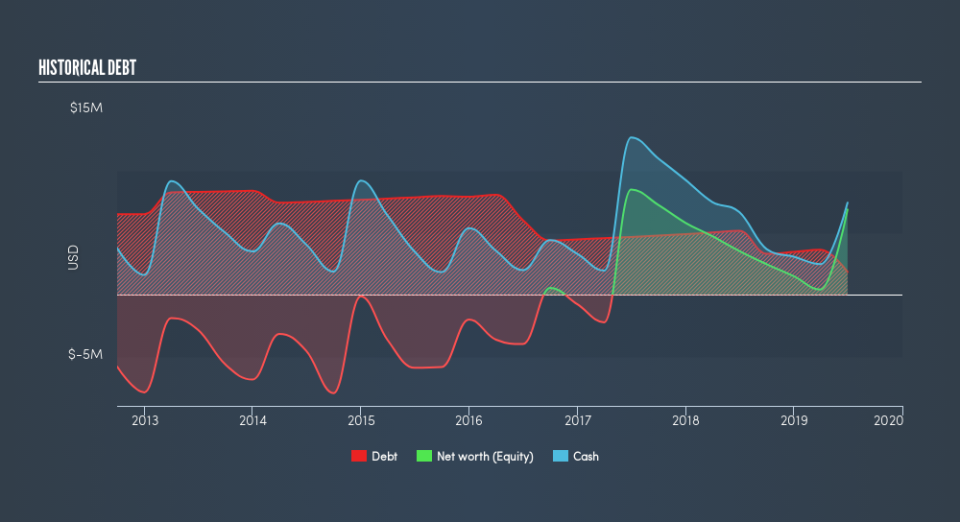MRI Interventions (NYSEMKT:MRIC) Has Debt But No Earnings; Should You Worry?

Warren Buffett famously said, 'Volatility is far from synonymous with risk.' It's only natural to consider a company's balance sheet when you examine how risky it is, since debt is often involved when a business collapses. Importantly, MRI Interventions, Inc. (NYSEMKT:MRIC) does carry debt. But should shareholders be worried about its use of debt?
When Is Debt A Problem?
Debt and other liabilities become risky for a business when it cannot easily fulfill those obligations, either with free cash flow or by raising capital at an attractive price. In the worst case scenario, a company can go bankrupt if it cannot pay its creditors. However, a more usual (but still expensive) situation is where a company must dilute shareholders at a cheap share price simply to get debt under control. Of course, the upside of debt is that it often represents cheap capital, especially when it replaces dilution in a company with the ability to reinvest at high rates of return. When we examine debt levels, we first consider both cash and debt levels, together.
Check out our latest analysis for MRI Interventions
What Is MRI Interventions's Debt?
The image below, which you can click on for greater detail, shows that MRI Interventions had debt of US$1.87m at the end of June 2019, a reduction from US$5.19m over a year. However, its balance sheet shows it holds US$7.46m in cash, so it actually has US$5.59m net cash.
How Healthy Is MRI Interventions's Balance Sheet?
We can see from the most recent balance sheet that MRI Interventions had liabilities of US$3.25m falling due within a year, and liabilities of US$3.11m due beyond that. Offsetting this, it had US$7.46m in cash and US$1.37m in receivables that were due within 12 months. So it can boast US$2.47m more liquid assets than total liabilities.
This surplus suggests that MRI Interventions has a conservative balance sheet, and could probably eliminate its debt without much difficulty. Succinctly put, MRI Interventions boasts net cash, so it's fair to say it does not have a heavy debt load! The balance sheet is clearly the area to focus on when you are analysing debt. But you can't view debt in total isolation; since MRI Interventions will need earnings to service that debt. So when considering debt, it's definitely worth looking at the earnings trend. Click here for an interactive snapshot.
In the last year MRI Interventions managed to grow its revenue by 37%, to US$9.2m. With any luck the company will be able to grow its way to profitability.
So How Risky Is MRI Interventions?
By their very nature companies that are losing money are more risky than those with a long history of profitability. And the fact is that over the last twelve months MRI Interventions lost money at the earnings before interest and tax (EBIT) line. Indeed, in that time it burnt through US$3.1m of cash and made a loss of US$5.4m. However, it has net cash of US$7.5m, so it has a bit of time before it will need more capital. With very solid revenue growth in the last year, MRI Interventions may be on a path to profitability. By investing before those profits, shareholders take on more risk in the hope of bigger rewards. For riskier companies like MRI Interventions I always like to keep an eye on whether insiders are buying or selling. So click here if you want to find out for yourself.
Of course, if you're the type of investor who prefers buying stocks without the burden of debt, then don't hesitate to discover our exclusive list of net cash growth stocks, today.
We aim to bring you long-term focused research analysis driven by fundamental data. Note that our analysis may not factor in the latest price-sensitive company announcements or qualitative material.
If you spot an error that warrants correction, please contact the editor at editorial-team@simplywallst.com. This article by Simply Wall St is general in nature. It does not constitute a recommendation to buy or sell any stock, and does not take account of your objectives, or your financial situation. Simply Wall St has no position in the stocks mentioned. Thank you for reading.

